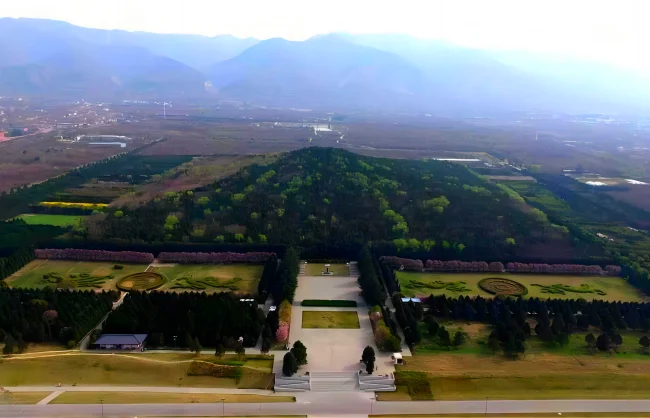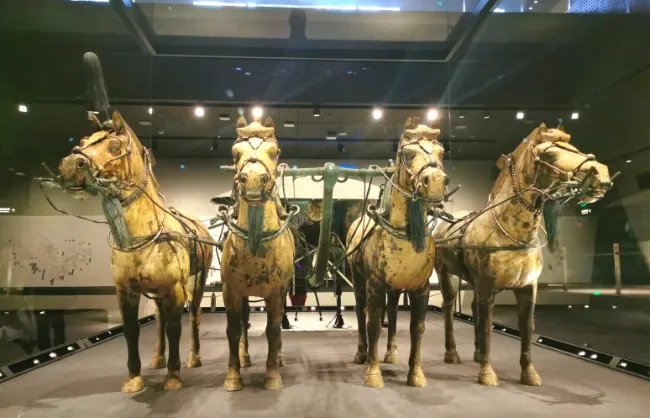Qin Shi Huang’s Tomb, Mausoleum of The First Qin Emperor
The Mausoleum of the First Qin Emperor is the tomb of Qin Shi Huang, located in Lintong District, Xi’an, Shaanxi Province, China, about 31 km east of Xi’an city center. The original name of the mausoleum is Lishan Garden, with the tomb placed between the Li Mountain to the south and the Wei River to the north. This location fulfills the geomagnetic requirements of ancient China.
The existing mausoleum stands at a height of 76 meters and faces east-west. It is believed to be the place where Emperor Qin Shi Huang’s coffin and accompanying burial artifacts are located. As one of the largest and culturally significant imperial tombs in the world, the central mausoleum is still unexcavated as of now.
The world-famous Terracotta Army near the mausoleum is part of the outer perimeter of Qin Shi Huang’s Tomb, which was constructed to guard the imperial resting place. When traveling to Xi’an, we highly recommend our clients cover both the Terracotta Army and the mausoleum area for a better understanding of the legendary emperor and culture and life during the Qin Dynasty.

Travel Information
- Location: in Lintong District, Xi’an, Shaanxi Province, China, about 31 km east of Xi’an city center, and about 2 km from the Terracotta Army
- Opening hours: 8:30-18:30 (Mar. 16 – Nov. 15); 8:30-18:00 (Nov. 16 – Mar. 15)
- Ticket price: CNY 120 per person (include both Mausoleum of The First Qin Emperor & Terracotta Army)
- Time needed: about 1.5-2 hours
History of the Mausoleum of the First Qin Emperor
Emperor Qin Shi Huang began to build the mausoleum for himself when he came to the throne at the age of 13. After the unification of the country in 221B.C.the project grew large in scale. Over 720,000 convicts from all parts of the empire were conscripted as laborers. The work continued even after the emperor’s death, taking in total 38 years. The fact that one of the satellite pits of the terra-cotta army, Pit NO.4, was unfinished and remained empty, suggests that the planned work was not completed.
Layout and Interior of Emperor Qin Shi Huang’s Tomb
Emperor Qin shihuang’s Mausoleum is very large, covering the total area of 56.25 sqare km. It is rectangular in shape and enclosed by two walls-the inner city wall and the outer city wall, forming the shape of the Chinese character”回”.
The inner wall measured 1,355m in length from north to south and 580m in width from east to west with a circumference of 3,870m, the area was 79 square meters. The outer wall was 2,186m in length from north to south and 976m in width from east to west with a circumference of 6,321m.The area was 213 square meter. The walls no longer exist but the foundations halved remained.
Both the inner and outer walls had a gate with gate tower on earth side, apart from the north side of the inner wall which had two gates. Both the inner and outer walls had watchtowers at the four corners. The large tomb lies in the south part of the inner city at the point of intersection of six gates. So many buildings that were above ground have been reduced to ruin or have simply vanished without a trace that it is difficult to determine what the original mausoleum might have looked like. But the numbers of unusually well-preserved relics beneath the ground have provided archaeologists with a good idea as to the design and overall layout of the mausoleum of Qin Shi Huang.
The mausoleum builders got the surprising achievements by their hard work, however their life lived in poor condition, rebellious peasants pillaged and burnt those buildings connected with the Qin dynasty, which was hated for its cruelty. The palaces and other buildings within the walls of the mausoleum were destroyed. Only the huge pyramid of the mound survived the devastation, although it is not known whether later grave robbers have plundered the tomb. In 1987 the mausoleum was listed by UNESCO as a World Heritage site.
Highlights of the Mausoleum of the First Qin Emperor (Lishan Garden)
The Bronze Chariots and Horses Museum
The Bronze Chariots and Horses Museum is the best highlight of the Mausoleum of the First Qin Emperor. The bronze chariots and horses in this museum are renowned as the “Crown of Bronzes”, boasting the largest, most intricately structured, and best-preserved ancient vehicles unearthed in China. The museum was opened to the public in 2021 and is located about 240 meters away from the original burial pit.
Be one-half scale of the actual imperial vehicles, the bronze chariots and horses were buried as part of Qin Shi Huang’s funerary items, and adorned with many gold and silver ornaments, offering a glimpse into the advanced metallurgy and craftsmanship of the Qin dynasty.

Burial Pit No. 9901 (Pit of the Hundred Entertainers)
A fascinating archaeological site within the Mausoleum of the First Qin Emperor, the “Pit of the Hundred Entertainers” contains many unique terracotta figurines known as the “Hundred Entertainers,” which were intended to serve as a diverse entertainment troupe for the emperor in the afterlife. Unlike the solemn expressions of the Terracotta Warriors, these figurines display a wide range of dynamic poses, showing various forms of ancient Chinese entertainment.
The forms of entertainment in the pit include music, dance, and acrobatics, which were popularized during the Spring and Autumn period and the Warring States period and offer visitors a look into the vibrant world of entertainment in ancient China.
Burial Pit No. K0006 (Pit of Civil Official Figurine)
This pit is composed of three parts: a sloping gateway, a front chamber, and a rear chamber. The front chamber primarily contains terracotta figurines, while the rear chamber contains horse bones. The Civil Official Figurine Pit is one of the rare pits in the Mausoleum of the First Qin Emperor that was unburned, with its wooden structures being relatively well preserved.
Travel Tips for the Mausoleum of the First Qin Emperor
- The entrance fee of Qin Shi Huang’s Tomb is included in the ticket of Terracotta Warriors and Horses.
- The tomb is about 2 km from the Terracotta Army, visitors can take the free shuttle bus to travel between these two sites.
- It’s highly recommended to explore the Lishan Garden area by a sightseeing car (CNY 15 per person) considering its large size.
- It’s recommended to visit the mausoleum (Lishan Garden) area first before heading to the Terracotta Army site. Please leave about one hour for the shuttle bus ride between these two sites.
- Both of these two sites stop to check tickets at 17:00, please plan your itinerary accordingly.
If you like, our expert team is glad to arrange you a Xian tour with Terracotta Army and the Mausoleum of the First Qin Emperor. Feel free to contact us regarding your preference and requirements.









